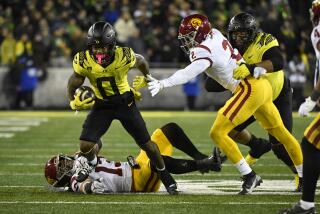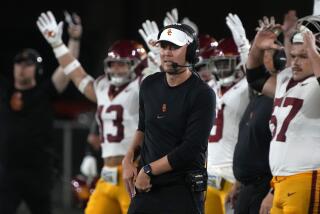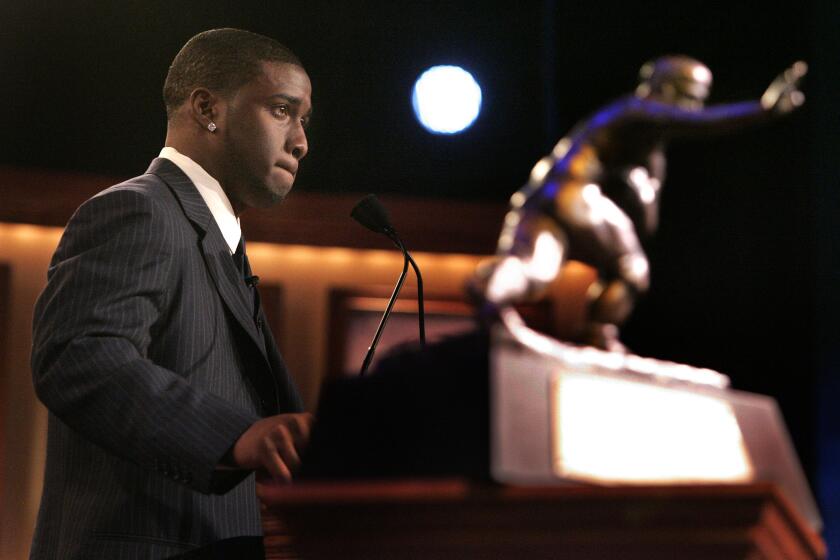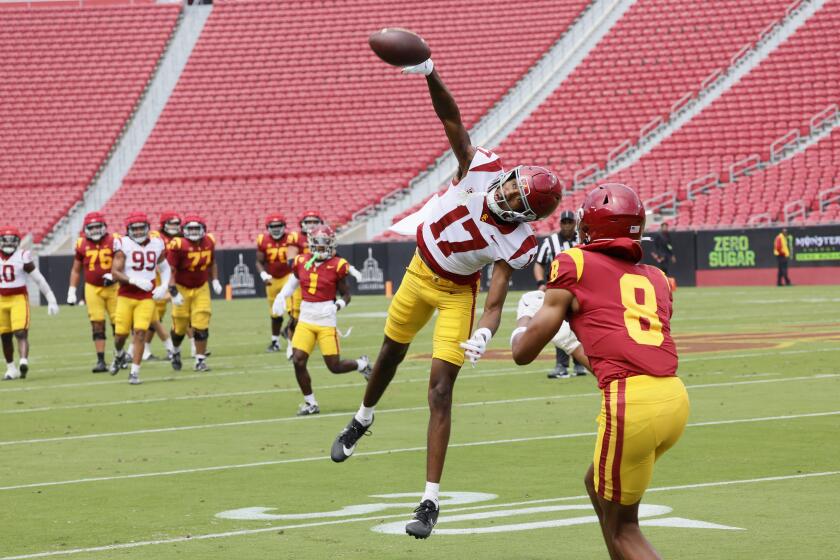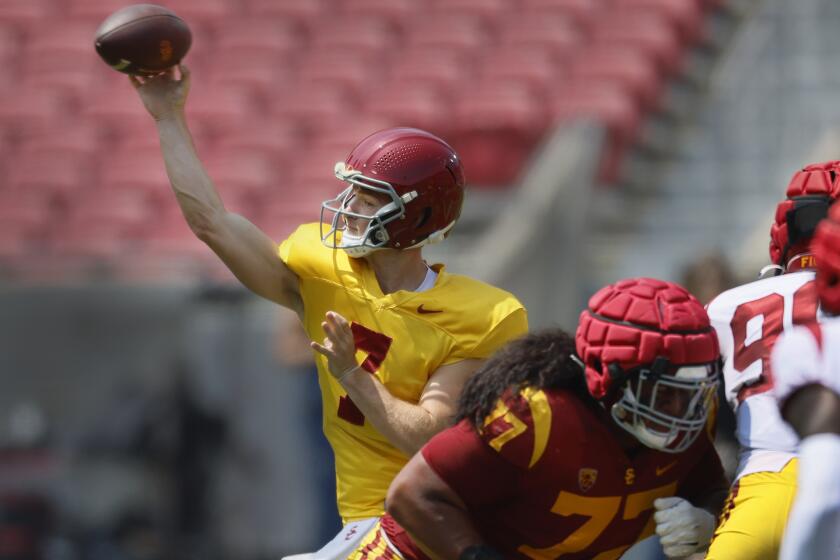Pac-12 could be exciting … while it lasts
USC’s Andre Heidari recorded the first three points in Pacific 12 Conference history Saturday when his 47-yard kick crawled over a Coliseum crossbar with 4:41 left in the first quarter.
OK, so it wasn’t the moon landing.
“That’s one small kick for man,” Heidari did not say afterward, “one giant leap for Trojankind.”
USC’s Marc Tyler scored the first Pac-12 touchdown, on a six-yard scamper around left end late in the first period.
Matt Barkley (USC) tossed the new league’s first interception, T.J. McDonald (USC) recovered the first fumble and Matt Kalil (USC) got the first blocked field goal with no time left to preserve USC’s first (this year) 17-14 win.
None of this will be studied by historians, yet it probably deserves a time capsule.
Was there even another team there?
Yes. Utah eventually did show up, shaking off opening-conference jitters to push the Trojans to the precipice.
Utah didn’t score its first Pac-12 points until 34 seconds were left in the first half, but then took comfortably to its new South Division digs.
Utah had the ball, and a chance, and a kick.
“Pac-12 football: Catch it while it lasts?”
USC versus Utah wasn’t the only exciting game involving Pac-12 schools Saturday. California edged Colorado, 36-33, in an overtime thriller in Boulder.
However, that event goes in the books as “nonconference” because it was scheduled before Utah and Colorado joined the league July 1.
The flyover freshness to the league’s christening was only undercut by the gurgling undercurrent running through college football.
The day a new league opens, the first question should not be, “How long will it last?”
Yet, that was one of the stadium-warming gifts thrown at Pac-12 Commissioner Larry Scott.
Will the Pac-12 last long enough for USC and Utah to meet again next season in the same configuration?
“I hope it does,” Scott said in the press box before the game. “The ink isn’t dry on the new logos.”
Scott, though, has been sending out confusing signals ever since news broke days ago that Texas A&M was probably headed to the Southeastern Conference.
That set off a frenzy of speculation suggesting the Big 12 might dissolve, with the Pac-12 ready to absorb Oklahoma, Oklahoma State, Texas and Texas Tech.
It was Scott, after all, who started the road-to-superconference talk with his failed attempt last year to lure six Big 12 schools to form a Pac-16.
Texas A&M was tentatively accepted by the SEC this week, but the deal is on hold pending legal challenges from remaining Big 12 schools.
Everything is in limbo, with commissioners having to tread very carefully.
The tenor of Scott’s message hass softened. He described it as refinement. “Tying to be more clear,” he said.
On Aug.31, Scott released a statement saying that though the Pac-12 was not looking to expand, “I have made clear my vision that the health, stability and future of college athletics will likely include further consolidation and realignment.”
Last week, before Oregon’s opener against Louisiana State in Texas, rumors swirled that Oklahoma was perhaps days from joining the Pac-12.
Scott, before that game, said he had received calls from other schools and told reporters, “Further consolidation and more stability would be good for college football.”
Friday, before Arizona State hosted Missouri in Tempe, Scott said he hoped there was no expansion and “all conferences that are 12 stay at 12. That would get our vote.”
So which is it?
Scott said he had not really changed positions.
Truth is, Baylor’s threatened legal action has made nervous everyone thinking expansion.
You have to read Scott’s words carefully to understand that the fundamentals of possible expansion have not changed.
The Pac-12 does not have to be proactive here, and Scott has publicly challenged the term “predatory.” The key words are “if all conferences that are 12 [teams] stay at 12.”
The SEC has already conditionally agreed to accept Texas A&M. That would be team No. 13.
“If that happened,” Scott acknowledged, “we’re in a different world.”
The SEC at 13 would likely trigger an arms race to 16.
Oklahoma has already intimated it might want to join the Pac-12 and would bring Oklahoma State with it.
The Pac-12 could seek two more teams immediately or stay at 14 for a year or two. Texas appears a less likely option unless the Longhorns are willing to give up the network they just launched with ESPN. The Pac-12 demands that revenue be distributed equally.
For now, but check your watches, it’s the dawning of a new Pac-12.
“People love the situation we’re in today,” Scott said. “They hope the world does not change.”
Of course, it will change.
And then, maybe, everything changes.
More to Read
Go beyond the scoreboard
Get the latest on L.A.'s teams in the daily Sports Report newsletter.
You may occasionally receive promotional content from the Los Angeles Times.

